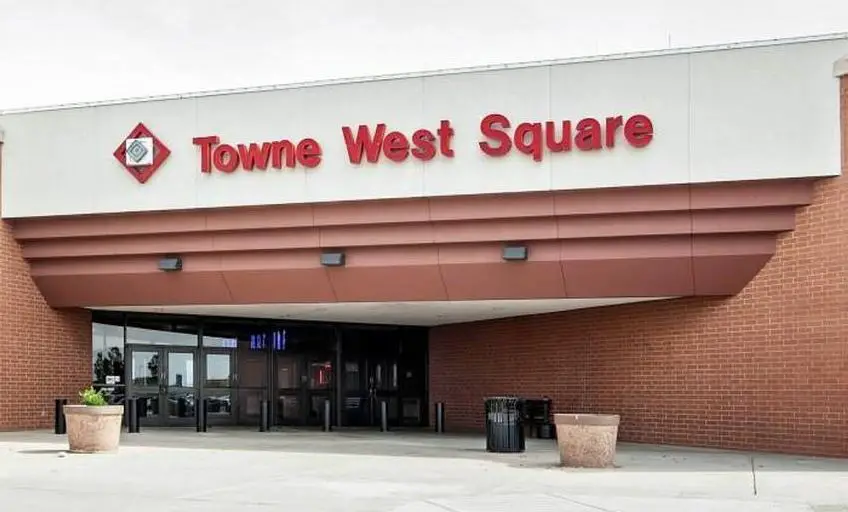The Beginning
Towne West Square opened on March 6, 1981. Melvin Simon & Associates developed the mall. It featured original anchor stores like Dillard's, Henry's, JCPenney, Montgomery Ward, and Service Merchandise. The mall covered over 950,000 sq ft of leasable area.
Towne West Square quickly became a popular shopping destination. It offered a mix of local and national retailers. Henry's, one of the original anchors, closed in 1988. This space later became 54 West Music Hall.
The mall was strategically located at 4600 West Kellogg Drive, Wichita, Kansas. Its accessibility made it a go-to spot for shopping. Wichita Transit provided public transit access to the mall.
Melvin Simon & Associates aimed to create a premier shopping experience. They achieved this by attracting top retailers and offering a variety of stores. Towne West Square had its grand opening during commercial growth in Wichita.
It positioned itself as a key player in the retail market, catering to the community's shopping needs and becoming a major retail hub for things to do in Wichita, Kansas.
Growth and Expansion
Towne West Square grew rapidly in its early years. In 1993, Sears opened a new store in the mall, relocating from the Twin Lakes Shopping Center. This move expanded the mall's retail options and attracted more shoppers.
During its peak, Towne West Square offered a diverse shopping experience. The mall housed popular retailers like The Gap, Victoria's Secret, and Foot Locker.
Food courts and entertainment options like movie theaters made it a comprehensive shopping destination.
The variety of stores catered to different tastes and preferences, making it a popular choice for families and young shoppers.
The mall's location at Kellogg U.S. 54 and Interstate 235 intersection made it easily accessible. This prime location contributed to its success, drawing customers across Wichita and surrounding areas.
The mall's ample parking space and convenient public transit access added to its attractiveness.
Towne West Square also hosted numerous community events and promotions, including holiday sales, fashion shows, and cultural festivals.
These activities created a vibrant atmosphere, keeping the mall bustling with activity. The mall's management continuously sought ways to enhance the shopping experience and maintain high foot traffic.
The Decline Begins
The decline of Towne West Square started becoming evident in the early 2000s. Montgomery Ward, another anchor, closed its doors in March 2001 due to bankruptcy.
This was part of a larger nationwide shutdown of Montgomery Ward stores. Losing this anchor left a void that was hard to fill. The space remained vacant for some time, impacting the mall's attractiveness.
In December 2014, Sears shut down its Towne West Square operations. Sears' closure removed another key anchor, further diminishing the mall's retail variety.
The vacant space was later converted to office use by Convergys, which did not draw the same level of foot traffic as a retail store.
Despite these setbacks, management tried revitalizing the mall by attracting new tenants and hosting events.
However, the rise of online shopping and changing consumer habits made it difficult to reverse the decline.
Efforts to rejuvenate the mall were often met with limited success, and the once-bustling shopping hub started showing signs of decay.
Attempts at Revitalization
Towne West Square management tried hard to revitalize the mall. In 2017, Dillard's closed its women's store and converted its men's store to a Dillard's Clearance Center.
This move aimed to attract bargain hunters and boost foot traffic. However, it didn't fully restore the mall's former glory.
Management also brought in new tenants. Local businesses and smaller retailers filled some empty spaces, creating a mix of stores, but the absence of major anchors like Montgomery Ward and Sears was noticeable.
The mall hosted events like holiday sales and community gatherings to attract more visitors.
Renovation efforts included painting parts of the mall, updating decor, and improving lighting to create a more inviting atmosphere.
These changes temporarily increased customer visits, but sustaining high traffic levels proved challenging. Competition from other shopping centers and online retail continued to impact the mall's performance.
Despite these revitalization attempts, Towne West Square struggled to regain its former status. The retail landscape had changed, and consumer habits had shifted.
Service Interruptions and Tenant Challenges
Towne West Square's financial issues became more apparent over time. On July 31, 2020, JCPenney listed its store for sale due to bankruptcy.
Although the store remained open, this highlighted the mall's financial instability. The mall's problems went beyond just one tenant.
Power disconnections by Evergy started in June 2023. Unpaid bills led to power cuts on multiple occasions.
These disconnections occurred again in September and November 2023, disrupting business operations.
The mall managed to pay the bills and restore power each time, but these incidents showed deeper financial troubles.
In April 2024, the mall faced another setback when its water systems were shut off. This further strained relationships with tenants.
Anchor stores like JCPenney, Dillard's Clearance Center, and Dick's Sporting Goods had separate utility accounts, so they weren't affected. However, smaller retailers struggled with the lack of basic services.
The ongoing financial struggles impacted the mall's reputation. Tenants began to look for more stable locations. The uncertainty surrounding the mall's future made attracting and retaining businesses difficult.
Despite efforts to address these issues, Towne West Square's financial woes remained a persistent challenge.
Towne West Square: Future Uncertainty
From 2023 to 2024, Towne West Square in Wichita, KS, experienced a tumultuous period. Frequent power and water disconnections plagued the mall, impacting tenants and operations.
Tenants were repeatedly warned about possible future shut-offs. The uncertainty makes it difficult for businesses to plan and maintain regular operations.
The ongoing utility issues erode tenant confidence and push some to seek more reliable locations.
Despite these challenges, the mall's management continues to seek solutions. They explore options to stabilize operations and retain tenants.
However, the frequent service interruptions and financial instability create an environment of uncertainty, making recovery efforts challenging.

